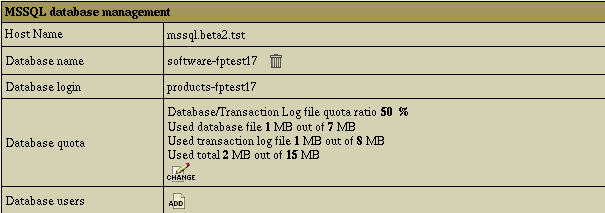|
Microsoft SQL database is a database management system
based on Windows platform. It allows you to add, access, and
process stored data.
Unlike other SQL databases, MS SQL databases are dependable on logins
which give access to MS SQL Server. Once login is created, you can create databases associated with it.
After creating a database, H-Sphere automatically creates users with specific permissions.
Beside customer users, H-Sphere automatically creates an H-Sphere user for the owner login.
So, to create and manage MSSQL database, follow the given sequence:
Creating Microsoft SQL Logins
To create an MS SQL login, do the following:
- Select MS SQL in the Databases menu.
- Click the Add New MS SQL login icon:

- Enter login and password into the MS SQL Login Creation Form that shows:

Note: you can change password by clicking the Change
icon against the login name in the Controls section.
- Click the Submit button.
- Agree to additional charges.
Note: To delete login, click the Trash
icon against the login name, in the Controls section.
Important: With deleting a login, H-Sphere will delete all DBs created under
it and also all users under the DBs. Also if you have some users under this login
that are associated with another DB, these users will be deleted as well.
Please make sure you want to delete the login before clicking Trash.
Creating MS SQL Databases
To create a MS SQL database, do the following:
- Select MS SQL DBs in the Databases menu.
- Click the Add database icon at the bottom of the page that appears:

- Fill the MSSQL Database Creation form:

- Click the Submit button.
- Agree to additional charges.
Note: To delete a database, click the Trash icon against
the database name in the Controls section.
When MS SQL creates a database, it automatically creates a user with the
same *login* as the one this database was created with.
Adding New MS SQL Database users
After you have created the database, it appears in the database
list:

Here you can learn how to add users to individual MS SQL
databases. To add a new user, do the following:
- Select MS SQL DBs in the Databases menu.
- On the page that appears, click the name of existing database or click the
Edit icon in the Controls section. The following form will show:

- At the bottom of the page click Add icon against the
Database users field. The following form will appear:

- Enter user name and click Add.
* When you are creating a new user to the database, the system offers you
to choose from the logins that aren't used by this database.
It won't display this databse owner's login, because when MS SQL creates a
database, it automatically creates a user with the same *login* as the one
this database was created with. One login can be used only by one user within
a database. So, login you have used to enter the database is already being
used by you and can't be used to create a new user on this database.
- Agree to additional charges if any.
Changing MS SQL Database quota
Total quota size is the disk space allocated for the
database file and the transaction log file.
Database/Transaction Log file quota ratio is the portion
of disk space allocated for the database file. If you set
the total quota size to 100 MB and the database/transaction
log file quota ratio to 40%, then the maximum database file
quota is 40 MB and the maximum log file quota is 60 MB. The
more dynamic your database is, the bigger transaction log
file quota ratio should be.
To change the quota, do the following:
- Select MS SQL DBs in the Databases menu.
- On the page that appears click the name of an existing database.
- On the form that shows, click the Change quota icon
against the Database quota field.
- Enter new database log file ratio and total quota size on
the next page:

- Click Submit.
- Agree to additional charges if any.
Managing MS SQL databases (MS SQL Manager)
You can manage your MS SQL databases through a web-interface with
ASP Enterprise Manager,
in your control panel called MS SQL Manager. To set up and launch MS SQL Manager:
- Select the Domain Settings menu.
- On the page that appears, click Edit for Web Service.
- On the Web Options page, enable ASP and ASPNET
if they are disabled. Then enable MS SQL Manager at the bottom of the page.
- Click the Magnifying glass icon that appears to launch MS SQL Manager.
You'll be asked to choose the login to connect to your MS SQL databases:

|